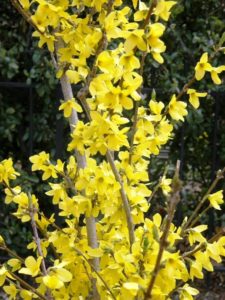 The deciduous forsythia bush offers arching branches of bright yellow flowers for a splash of spring color in your yard. Forsythia bushes produce flowers first, with the green foliage appearing once the flowers fade. This attractive bush is available in several varieties for U.S. Department of Agriculture plant hardiness zones 4 through 9. Plant the forsythia any time of the year in areas where freezing temperatures are not an issue, otherwise fall is the best time to add this bush to your landscape. Move and transplant a forsythia during the winter season, when the bush is not actively growing.
The deciduous forsythia bush offers arching branches of bright yellow flowers for a splash of spring color in your yard. Forsythia bushes produce flowers first, with the green foliage appearing once the flowers fade. This attractive bush is available in several varieties for U.S. Department of Agriculture plant hardiness zones 4 through 9. Plant the forsythia any time of the year in areas where freezing temperatures are not an issue, otherwise fall is the best time to add this bush to your landscape. Move and transplant a forsythia during the winter season, when the bush is not actively growing.
- Choose a location with full sunlight and well-draining soil. Verify the mature height and spread of the forsythia variety chosen. Check for overhead obstructions when planting tall varieties and allow enough space between the forsythia and other plants to accommodate the branch spread.
- Test the soil with a home kit to verify it has a range of 6.8 to 7.7. Lower the pH by working ground rock sulfur into the soil or raise the pH using horticulture limestone. Follow the package instructions for an application rate based on the current pH. Moisten the soil well after applying the amendment.
- Dig a planting hole that is at least two times wider than the root ball and the same depth.
- Set the forsythia root ball into the hole. Verify the top of the root ball is at ground level or just slightly above. Above planting the bush too deep.
- Fill the removed soil around the root ball to hold the bush in place. Pack the soil firmly around the roots.
- Saturate the hole with water to compact the soil around the roots. Add more soil if needed once the water recedes. Discard any excess soil removed from the hole.
More information about planing a forsythia
Courtesy SFGate Home Guides
